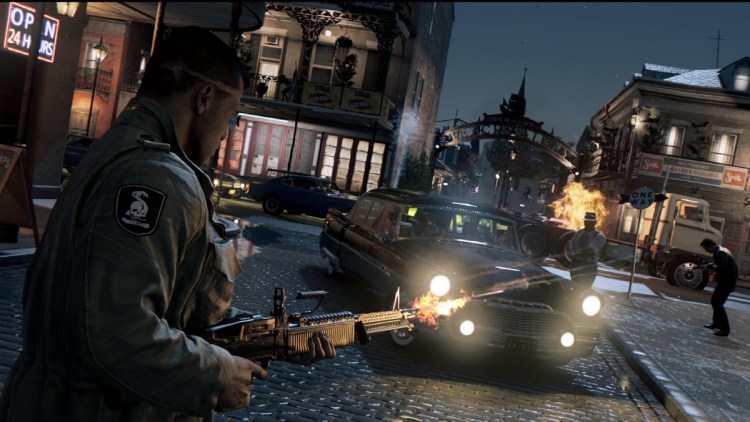Mafia III has one of the best stories about racism in America in the historical context of New Orleans (called New Bordeaux) during 1968. It tells the tale of a mixed-race African-American man, Lincoln Clay — a veteran of the special forces in Vietnam — as he pursues revenge against the Italian mob. And back in the 1960s, that means he pursues revenge against the entire racist system of the corrupt judicial, police, and government bodies in the Deep South. I liked it because it felt so authentic, portraying the view of an anti-hero, a character who is not meant to be someone we admire as a traditional game hero.
Through cutscenes and action, the developers at 2K’s Hangar 13 convey the dilemma of a good man fighting against a corrupt system and trying not to become evil while doing deeds of great violence that are necessary to bring down that system. It is an epic story with great characters and narration. The beginning is masterful thanks to flashbacks and flash forwards that show the gravity of the story. But the game is held back by a failure to fill out every part of the open world. You wind up with a great story and weak gameplay — lots of highs and lots of lows.
The open world shooter is a great first title from Hangar 13, run by game veteran Haden Blackman. It had the potential to be as great as Grand Theft Auto V (another story about criminal anti-heroes in an open world), but too often, it feels as if you are playing a buggy Grand Theft Auto III, with poor gameplay and graphics. We are in the thick of a very busy season of game launches, and you should think hard about whether you’ve got the 30 hours to invest in this game. Ultimately, I enjoyed it because of the story, but I tolerated the gameplay. And many other critics and fans are disappointed with it overall, based on the poor reviews. It’s out now on the PlayStation 4, Xbox One, Windows, and Mac.
Editor’s note: This story has some spoilers, but we’ve tried to minimize them. Avoid the videos if you want to further minimize the spoilers. Check out our Reviews Vault for past game reviews.
What you’ll like
Mafia III immerses you in a tumultuous year in history

Above: Lincoln Clay and Thomas Burke in Mafia III.
From the moment Clay returns from Vietnam, you feel like you are in the South in the spring of 1968. As you drive Clay’s muscle car, the radio starts playing Barry McGuire’s Eve of Destruction, an appropriate song about the fears of nuclear war and the unceasing violence of the 1960s. I loved listening to songs like The Rolling Stones’ Paint it Black and The Animals’ We Gotta Get Out of This Place, as they really set the mood of the game. The title has more than 100 licensed songs, but even with that number, I heard many of them over and over while driving.
The cars and buildings are historically accurate, and the city has familiar sights, such as the bawdy French Ward. As you pass by three black women on the street, they talk about the assassination of Dr. Martin Luther King Jr. Flash-forward scenes show pictures of the grisly violence of mob wars and the death of Bobby Kennedy. Riots broke out in American cities in response to King’s assassination, along with protests like the black power salute at the Olympics in Mexico City.
The horrors of the Vietnam War, which broadcasted daily on the evening news, divided America itself during this year. In the game’s story, the black mob leader Sammy Robinson, who oversees the black part of town as long as he kicks money up to the Italian mob boss Sal Marcano, raises an orphaned Clay. Robinson falls behind in payments as Haitian criminals move into his turf, and Marcano holds it against him.

Above: New Bordeaux in Mafia III.
On a local level, the Italian mob controls illegal gambling, drugs, and prostitution while corrupt police and politicians line their pockets with bribes and do what they can to oppress African-Americans. Against that authentic backdrop, Bill Harms, lead writer for Mafia III at Hangar 13, said in an interview with GamesBeat that Clay emerges as a “gifted anti-hero.”
The storytellers are unflinching in depicting how volatile the times were, Harms said. As a result, the title features plenty of harsh language, including the constant use of the N word and rampant stereotyping by bad characters.
“We felt that if we didn’t at least include issues of race and racist language, we’d do a disservice to the people who’ve experienced that,” Harms said.
Characters, such as Father James Ballard and CIA agent James Donovan, narrate the story in excellent fashion, and they try to convey Clay’s behavior to those who didn’t know him in flash-forward scenes. Ballard doesn’t condone the violence, while Donovan celebrates it. But neither judges the disenfranchised veteran strongly because the game does such a good job contextualizing Clay’s one-man uprising against the injustices of a whole city and time.

